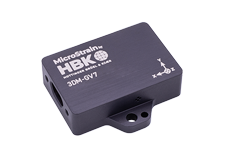Recent
-
-
MicroStrain by HBK at XPONENTIAL 2024
May 7, 2024 / Inertial
-
-
-
Introducing Version 4.0.0 of the MicroStrain ROS Driver
Jan 29, 2024 /
-
-
-
Enhancing Vision-Based Robots with IMUs
Dec 19, 2023 /
-
The Latest Gateways for Wireless Sensing Networks are Small but Mighty
- By Beth /
- Published Fri, 04/06/2018 - 08:23

Gateways, as their name suggests, are critical points in any wireless sensing network (WSN). They handle the communication "traffic" in any sensor-connected system. In their earliest iterations, gateways were sizable, somewhat unwieldy units. More recently, however, gateways have become much smaller, following a trajectory similar to that of desktop computers, whose computing power was gradually condensed into smaller and smaller devices. Our WSDA®-200-USB gateway is a typically-sized USB device, measuring only 2.29 inches (58.2 mm) by .80 inches (20.3 mm).
The WSDA-200-USB is also low cost, even though it offers users access to LXRS+ wireless protocol, a state-of-the-art advancement over existing protocols. LXRS+ has the performance and reliability of hardwired systems coupled with the simplicity of a wireless network. It is an optional feature that is compatible specifically with the WSDA-200-USB and G-Link®-200 or V-Link®-200 wireless sensor nodes (although the WSDA-200-USB is also compatible with the legacy LXRS protocol and all legacy LORD wireless sensor nodes).
The USB gateway collects time synchronized data from scalable networks of nodes and provides seamless communication between those nodes and a host computer. A web-based portal makes data visualization, navigation and analysis a quick and easy process. Hundreds of sensors can be managed from a single gateway.
Several technologies support the system's lossless performance and high level of accuracy. All nodes communicate directly to the gateway, and each network operates on a designated frequency channel within the 2.4GHz license-free ISM band. Utilizing a star network topology (one gateway, many sensors) allows the network to maintain tight timing accuracy by means of a time beacon sent in precise intervals. The beacon contains a UTC timestamp and is used by the wireless sensor nodes to synchronize sensor sampling and accurately schedule transmissions.
Each WSDA and sensor node uses a high-precision, temperature compensated oscillator as a time source. The drift rate of this part is within +/- 5ppm over the full temperature range (-40 to 85°c), only requiring the node to resynchronize at periodic intervals in order to maintain synchronization to within +/- 50 microseconds of the reference. The wireless protocol uses time-division multiple access (TDMA) for collision avoidance. With TDMA, time slots are assigned to each node for scheduling buffered data transmissions and acknowledgements.
We offer an open-source API that allows users of existing data collection systems to easily integrate a WSDA-200-USB gateway into a customer application. SensorConnect™ software gives users the flexibility to easily program nodes for continuous, periodic burst, or event-triggered sampling. LORD WSN systems are ideal for testing and measurement, remote monitoring, system performance analysis and embedded applications. Our data collection and aggregation can support structural health monitoring; equipment performance monitoring, verification, evaluation and diagnostics; and environmental monitoring. Industries that can benefit from the deployment of WSN systems range from healthcare to aerospace to off-highway equipment.
Wireless simplicity, hardwire reliability.
View more LORD products at www.lord.com










